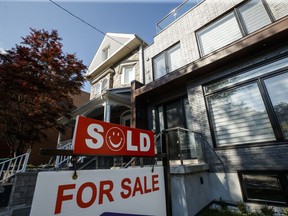Article content
TORONTO — The Toronto Regional Real Estate Board says August sales were down 34 per cent since last year, but up almost 15 per cent from July, as buyers returned to the market to take advantage of prices that eased from winter’s elevated levels.
Article content
The board said Friday that sales for the month amounted to 5,627 compared to 8,549 last August and 4,900 in July 2022.
Article content
The 34 per cent year-over-year drop was a lower rate of decline than the previous four months, but comes at a time when the region’s real estate market has cooled significantly from the heated conditions seen as the year began.
Climbing interest and mortgage rates in recent months have put a damper on sales and started to weigh on prices, ending bidding wars and encouraging prospective buyers to sit on the sidelines and wait for greater price drops.
Those that ventured into the market in recent weeks found the prices were below those seen in the frenzied winter months, but nonetheless higher than they had been a year and even a month ago.
Article content
On a year-over-year basis, the home price index was up by 8.9 per cent and the average selling price for all home types combined was up by 0.9 per cent to $1,079,500. However, the index was lower compared to July.
The seasonally adjusted average selling price was $1,130,463, up about two per cent month-over-month, but down about 12 per cent from $1,285,129, when the region experienced its highest average price in the last 12 months.
Monthly growth in the average price alongside a dip in the index suggests a greater share of more expensive home types sold in August, TRREB said.
New listings last month totalled 10,537, down less than one per cent from 10,615 last August.
The board also used its monthly real estate report to call for policy changes.
Article content
The board wants the Office of the Superintendent of Financial Institutions to consider removing the stress test for existing mortgage holders who want to shop for the best possible rate at renewal rather than forcing them to stay with their existing lender to avoid the stress test.
The stress test sets the qualifying rate on uninsured mortgages at either two percentage points above the contract rate or 5.25 per cent, whichever is greater.
“There is room for the federal government to provide for greater housing affordability for existing homeowners by removing the stress test when existing mortgages are switched to a new lender, allowing for greater competition in the mortgage market,” said Kevin Crigger, TRREB’s president, in a release.
“Further, allowing for longer amortization periods on mortgage renewals would assist current homeowners in an inflationary environment where everyday costs have risen dramatically.”
This report by The Canadian Press was first published Sept. 2, 2022.

